Sonic Advance: The Trilogy That Deserves a Second Chance
Revisiting Sonic's "other" 2D classics
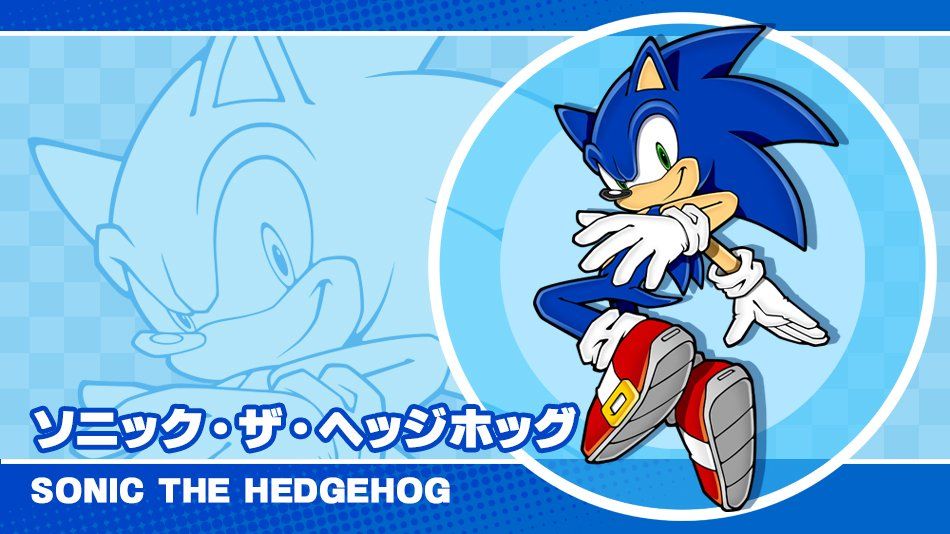
Sonic the Hedgehog is celebrating his 31th anniversary on June 23rd. To mark this opportunity, SEGA is releasing Sonic Origins, a new collection of his classic 2D adventure days. The Genesis era is probably Sonic’s most beloved era, with many fans of the character declaring how the trilogy of games, Sonic 1, 2, 3 and Knuckles, are some of the most amazing 2D platform games ever made.
However, there is another 2D platforming trilogy starring the world’s most famous hedgehog. Released for the Game Boy Advance between 2001-2004, the Sonic Advance trilogy helped to bring the character and all his speed to the Nintendo handheld. All of this helped propel the development studio Dimps into being recognized as one of the best developers for 2D action.

Unlike its Genesis old brother, this trilogy never saw the light of a re-release, excluding the Wii U Virtual Console in Japan. While not universally beloved as other games in the 16-bit era, the Advance saga brought many changes to the formula, all while mixing the best of both classic and modern Sonic world.
To celebrate Sonic’s 31st anniversary, let’s remember the Advance trilogy and see why these games deserve a second chance to shine. For those unfamiliar or in need of a Sonic refresher, then let me introduce you to some of the most underrated titles in the Hedgehog's past.
Before Advance, There Was a Pocket Adventure
Although my focus on this article is about the games released on the Game Boy Advance, it would be unfair to ignore a certain title that laid the foundation for the future trilogy. This title is the Sonic Pocket Adventure, made by SNK for the Neo Geo Pocket Color, the handheld created by the famous arcade developer.
Produced by Takashi Nishiyama, the creator of Street Fighter, Fatal Fury, Art of Fighting and The King of Fighters, with supervision from SEGA, the game is a mix of the Genesis era games in a little package. The stages were based on Sonic the Hedgehog 2 while the music came from Sonic the Hedgehog 3 & Knuckles. The title was a fun game that replicated the feel and gameplay of the 2D era in a portable way, while also adding new things that later expanded in the Advance trilogy.
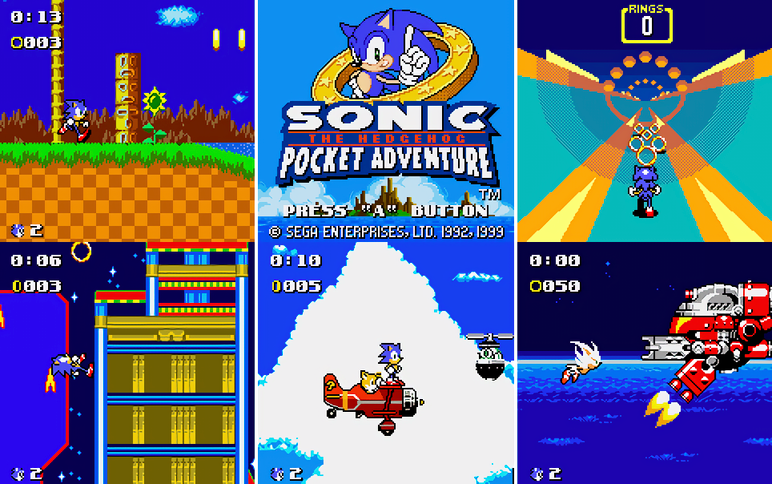
Released at the end of 1999, I remember Pocket Adventure as being one of the few Sonic games where IGN gave it a perfect 10/10. This game also marked the end of an era, being one of the last games ever produced by Nishiyama as an SNK employee. During the last part of the '90s, the company was going through financial problems and many developers were leaving. Nishiyama left SNK at the start of 2000, and together with many people who worked on Pocket Adventure, founded Dimps.
When SEGA announced it was turning into a third-party developer, plans for a new Sonic game for the Game Boy Advance were made. To help develop for the handheld, the Sonic Team turned to the newly formed Dimps for help and to co-develop together what would be the first step for the Blue Hedgehog in a new world; a world where he and Mario would be colleagues rather than rivals.
Sonic Advance: A Genesis Game With a Modern Feel
Being one of the first games announced by the now third party SEGA, both Sonic Team and Dimps, in a partnership, developed Sonic Advance. The primary aim was offering an experience similar to the Genesis games, while adding some tweaks that would make the title appeal to the fans of the Adventure series.
Allowing players to select Sonic, Tails, Knuckles, or Amy, the first game in the Advance series brought the mixture of high speed and platform action to the handheld. While the gameplay still had that same feel of the Genesis games, Dimps added some extra challenges as Special Stages that were hidden throughout the stages. For the Adventure fans, the visuals drew inspiration from the new 3D era and they adapted the Chao Garden to raise their own chaos away from the console.
Although the game had new music, stages and visuals, Advance still made some references to the Genesis era of Sonic. Some remixes of old tracks were available, as well as two classics. A secret hid in the game, where it was possible to play the entire adventure with Sonic and having Tails as a partner, similar to Sonic 2 and 3.

The main selling point of the game was the multiple, playable characters you could choose from. While Sonic, Tails and Knuckles still control just like the Genesis games, Amy, the recent addition, introduced a different take on the traditional style of gameplay the series offered. Using her PikoPiko Hammer, the Pink Hedgehog can’t turn into a ball, but she can hit enemies with her tool and access new paths.
Sonic, Tails, and Knuckles also gained new abilities, similar to the one present in Adventure. The game was also following the Genesis era design ideas to create the stages, offering many pathways that tested the players’ skills. With the four characters, this made sure that each run differed from each other.
Another unique feature was the multiplayer options that used everything the Game Boy Advance could offer. Advance was a pleasant introduction for new fans of the franchise, as well as a good game for veterans. Many consider it to be the best game in the entire trilogy and one of the best 2D games with the Hedgehog name.

Sonic Advance 2: The Birth of the Boost
While Advance was a Genesis experience with a fresh coat of paint, its sequel went a completely different route. The primary focus of Advance 2 is speed and momentum. With level designs created to make the player go fast, and the gameplay tweaked, this game is the start of the famed boost formula, introducing the mechanic in a beta stage.
If Advance focuses on challenging player skills while offering multiple paths that reward those who know how to platform. Advance 2 is more of a test of reflex. The player will be, most of the time, locked in high-speed moments while having to avoid enemies and bottomless pits. It’s a game made to be replayed many times till one masters the stage design, which might make some fans happy, while others won’t.
Offering the same characters as the last game, Advance 2 added Cream the Rabbit into the mix. Using her pet Chao, Cheese, we consider the little rabbit girl the easy mode of the game, with an attack that destroys many of the bosses in seconds. Meanwhile, another excellent addition to the gameplay is the trick system that allows for some aerial mobility after big jumps and ramps.
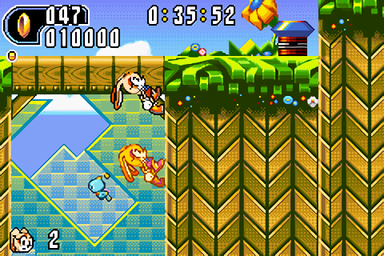
They made the trick system to allow for players to keep the momentum stacked, which makes for a quick gameplay. Unfortunately, because of the GBA screen limitations, one big problem Sonic Advance 2 faces is the screen size. Many jumps in the game are leaps of faith, and during high-speed moments, the player might get blindsided. The bosses are also a problem with how they are presented, being in a high-speed chase instead of the slow platform moments of the old games.
One of the biggest complaints regarding Advance 2, however, is related to the special stages. While Advance hides the entrance for the special stages inside the normal stages, making the player explore to be rewarded, Advance 2 forces the player to collect seven special coins. This forces players to play it safe and follow a specific part if they want to be rewarded with a chance to get a Chaos Emerald.
We can consider Sonic Advance 2 the basis for the future Rush duology made by Dimps, and the origin of the boost formula. Introducing the mechanic in a way that rewards players for keeping their momentum and maximum speed, instead of a press of a button, makes for an interesting game that was limited by the GBAs own shortcomings.
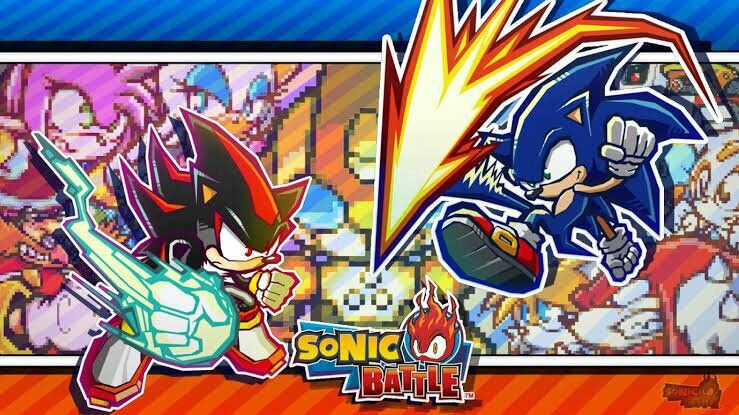
Sonic Battle: An Important Mention and a Worthy Spin-off
Before we talk about the next game in the trilogy, it’s worth mentioning a specific spin-off developed for the Game Boy Advance, Sonic Battle. Being an isometric fighting game using sprites from the Advance series, the game is part of the series canon and its story works as a prequel for Sonic Advance 3.
Sonic Battle is an underrated spin-off. Although not much remembered by fans, the game has some unique ideas, such as its gameplay system and a really interesting customization mechanic. The focus of the narrative is Emerl, a mysterious robot that can copy other people’s abilities. Sonic and his friends end up helping Emerl grow as a 'person' till the robot ends up sacrificing itself. It’s an emotional tale and a reason to play through the story mode.
Gameplay-wise, Battle allows for up to 4 players to fight in arenas. Similar to titles, such as Super Smash Bros, the aim is to K.O. opponents and score points. Before spawning into the matches, players can select up to two attacks to use that can be activated with a press of a button. The game is a fun pastime and the customization mechanic (allowing Emerl to be built in different ways) encourages players to invest more time into the game.
The most interesting fact about Sonic Battle is how, unlike the Advance trilogy, the game was developed entirely by the Sonic Team. Although the sprites from the main games were re-used, there were a lot of characters whose only appearance in the GBA were in this game, such as fan favorites, Shadow the Hedgehog and Rouge the Bat.

Sonic Advance 3: An Interesting Finale
While Advance 2 certainly made a rift with the fans of the blue hedgehog, Advance 3 returned to more traditional roots. With levels designs trying to be a mix of both platforming and speed sections of the predecessors, the game introduced a new mechanic, the Tag system, allowing for a player to create their own duo with exclusive abilities and play each stage differently.
This interesting mechanic allows for a bit of a customization and a novel experience each time the player mixes and matches the five characters. Some combinations are better than others, but thanks to the design of the stages, it’s possible to enjoy and discover new pathways. It’s a really fun gameplay mechanic that unfortunately was not brought back.
Sonic Advance 3 also focuses a little more on its story than its predecessors. While Advance 2 had some cut scenes, the new game goes with a bang, showing cut scenes and interactions between the characters during the adventure. While Eggman is still the main villain, his new robot, Gemerl, based on Emerl from Battle, steals the spotlight at the end, bringing a definitive ending to that character story arc.
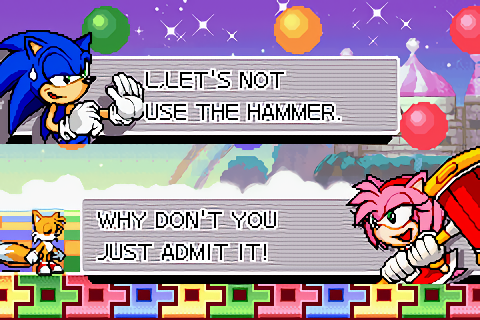
The game also brought some big changes to the experience. While the other games in the Advance series made each character have their own separate playtime, in Advance 3 is only possible to play the entire game one time. To make players replay the stages, the title offers some incentives, such as hidden chaos in the acts and a rank at the end of each run.
Advance 3 is an interesting finale to the whole trilogy and an era in Sonic itself. Being one of the last games where it was possible to play with over one of the Hedgehog friends, this title also marks the last appearance of the Adventure era cast, including the now deceased Deem Bristow as Eggman. The game also uses fan service really nicely, with a stage, Sunset Hill, being a memorable variant of the original Green Hill Zone, and some really nice Easter Eggs such as Amy animations when paired with Sonic or the Sonic & Knuckles box art logo when the duo is picked together.
Why These Games Matter
The Advance trilogy is a fascinating piece of Sonic history that many decide to ignore because it’s not the Genesis era. They are great 2D era games, with fluid sprite animation, interesting mechanics and some notable innovations. While many view the games as subpar compared to the classics, they are still fun, especially when they decide to be their own thing.
While Advance is still a good game, and probably the most well remembered, both its sequels are still titles that should be enjoyed. Advance 2 laid the foundation for the success of the Rush duology on the DS, while Advance 3 had an interesting tag mechanic that allowed for multiple different styles of approach to its many stages.
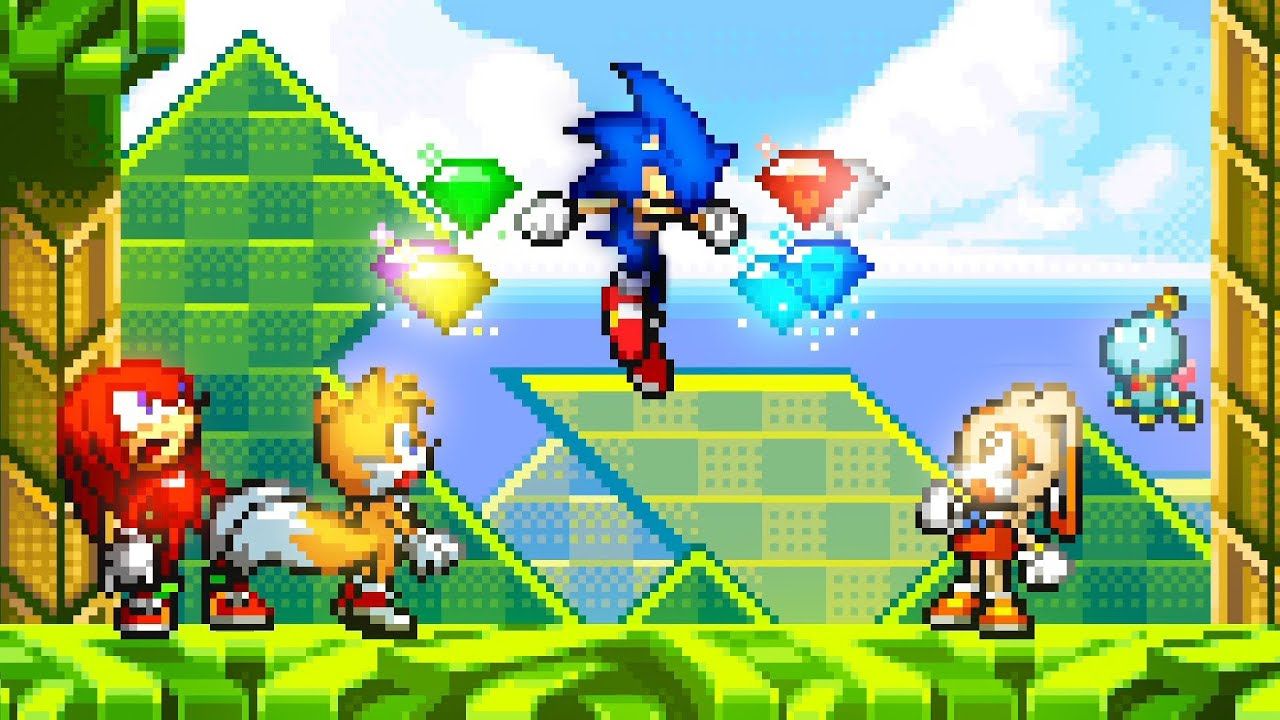
The problems regarding the games being developed for the GBA can be easily fixed. The soundtrack has the potential to be remixed. This would work wonders and a new resolution would make an Advance 2 first-time experience new and improved. Throw in Battle, and if they really want, Pinball Party, too, and SEGA could make a package that would introduce the newer fans of the Blue Hedgehog to some underrated games.
Of course, one of the main reasons these games are still on the original platform, at least in the west, is regarding its publishing rights. While SEGA published the games in Japan, the games reached this side of the world via THQ. While the company filed for bankruptcy in 2012, there is uncertainty about who has the rights for publishing in the west. And as fans know, Sega is usually cautious regarding games that might involve a potential lawsuit.
With the recent releases coming from both Capcom and Konami about franchises released on the GBA, and SEGA owns Sonic Origins, who knows? Perhaps some day, the Advance trilogy will have the chance to shine and remind fans that the Blue Hedgehog had a second era of excellent 2D games.